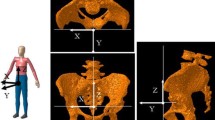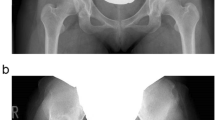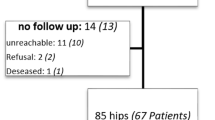Abstract
Purpose
Both rotational acetabular osteotomy (RAO) and eccentric rotational acetabular osteotomy (ERAO) are effective procedures for young patients with developmental dysplasia of the hip. However, no comparative study of biomechanical changes has been reported following these two procedures. We therefore explored the stress changes on femoral head after RAO and ERAO under different load conditions.
Materials and methods
Twelve female cadaveric hips without deformity were divided into RAO group and ERAO group. Stress value on femoral head was measured preoperatively and postoperatively after the vertical force was loaded on the cadaveric spine from 0 to 500 N. Stress change value was then calculated base on the measurements.
Results
In the RAO group, preoperative stress increased when loading on spine became larger, but postoperative stress changed its increasing trend into decreasing when the load was greater than 200 N (turning point). Same phenomenon was found in the ERAO group (turning point was 300 N). However, the difference between preoperative and postoperative stress was not statistically significant in both RAO and ERAO groups. Stress change value from each procedure showed similar trends. With the load growth, stress change increased firstly and then decreased, but the difference between RAO and ERAO was not statistically significant.
Conclusions
Both RAO and ERAO could correct the abnormal biomechanical effect of dysplastic hip; moreover, they may have similar biomechanical effects on femoral head, obtaining the same clinical outcomes. Non-biomechanical factors (surgical trauma, technical complexity, etc.) also play important roles in procedure selection.








Similar content being viewed by others
References
Gelfer P, Kennedy KA (2008) Developmental dysplasia of the hip. J Pediatr Health Care 22(5):318–322. doi:10.1016/j.pedhc.2008.05.005
Kambe T, Naito M, Asayama I, Koga K, Fujisawa M, Yamaguchi T, Yatsunami M (2003) Vascular anatomy for rotational acetabular osteotomy: cadaveric study. J Orthop Sci 8(3):323–328. doi:10.1007/s10776-002-0630-7
Russell ME, Shivanna KH, Grosland NM, Pedersen DR (2006) Cartilage contact pressure elevations in dysplastic hips: a chronic overload model. J Orthop Surg Res 1:6. doi:10.1186/1749-799X-1-6
Nozawa M, Shitoto K, Matsuda K, Maezawa K, Kurosawa H (2002) Rotational acetabular osteotomy for acetabular dysplasia. A follow-up for more than ten years. J Bone Joint Surg Br 84(1):59–65
Nozawa M, Shitoto K, Mastuda K, Maezawa K, Ogawa S, Yuasa T, Aritomi K, Kurosawa H (2006) Original methods to move femoral head medially and caudally after rotational acetabular osteotomy: especially to use ceramic spacer. Arch Orthop Trauma Surg 126(6):421–424. doi:10.1007/s00402-006-0156-z
Yasunaga Y, Yamasaki T, Matsuo T, Ishikawa M, Adachi N, Ochi M (2010) Crossover sign after rotational acetabular osteotomy for dysplasia of the hip. J Orthop Sci 15(4):463–469. doi:10.1007/s00776-010-1489-6
Kawasaki M, Hasegawa Y, Sakano S, Torii Y, Warashina H (2003) Quality of life after several treatments for osteoarthritis of the hip. J Orthop Sci 8(1):32–35. doi:10.1007/s007760300005
Yasunaga Y, Hisatome T, Tanaka R, Yamasaki T, Ochi M (2005) Curved varus femoral osteotomy for minimal dysplastic hip in patients older than 45 years of age: comparison with rotational acetabular osteotomy. J Orthop Sci 10(3):264–269. doi:10.1007/s00776-005-0885-9
Nozawa M, Maezawa K, Matsuda K, Kim S, Shitoto K, Kurosawa H (2009) Rotational acetabular osteotomy for advanced osteoarthritis of the hip joint with acetabular dysplasia. Int Orthop 33(6):1549–1553. doi:10.1007/s00264-008-0657-1
Ohsawa S, Inamori Y, Matsushita S, Norimatsu H, Ueno R (2000) Factors influencing joint-preserving operations in the treatment of the late stages of osteoarthritis of the hip. J Bone Joint Surg Br 82(3):369–374
Nozawa M, Shitoto K, Hirose T, Matsuda K, Michino K, Kajihara H, Maezawa K, Kurosawa H (2000) Rotational acetabular osteotomy for severely dysplastic acetabulum. Arch Orthop Trauma Surg 120(7–8):376–379
Ninomiya S, Tagawa H (1984) Rotational acetabular osteotomy for the dysplastic hip. J Bone Joint Surg Am 66(3):430–436
Ueda T, Tohkura A (1993) Evaluation of isokinetic hip strength after rotational acetabular osteotomy. Nippon Seikeigeka Gakkai Zasshi 67(12):1105–1113
Ninomiya S (1989) Rotational acetabular osteotomy for the severely dysplastic hip in the adolescent and adult. Clin Orthop Relat Res (247):127–137. http://www.ncbi.nlm.nih.gov/pubmed/2791382?dopt=Abstract
Hasegawa Y, Iwase T, Kitamura S, Yamauchi KK, Sakano S, Iwata H (2002) Eccentric rotational acetabular osteotomy for acetabular dysplasia: follow-up of one hundred and thirty-two hips for five to ten years. J Bone Joint Surg Am 84-A(3):404–410
Hasegawa Y, Kanoh T, Seki T, Matsuoka A, Kawabe K (2010) Joint space wider than 2 mm is essential for an eccentric rotational acetabular osteotomy for adult hip dysplasia. J Orthop Sci 15(5):620–625. doi:10.1007/s00776-010-1508-7
Takatori Y, Ninomiya S, Nakamura S, Morimoto S, Moro T, Nagai I (2000) Long-term results of rotational acetabular osteotomy in young patients with advanced osteoarthrosis of the hip. J Orthop Sci 5(4):336–341. doi:10.1007/s007760000050336.776
Greenhill BJ, Hainau B, Ellis RD, El-Sayed RM (1995) Acetabular changes in an experimental model of developmental dysplasia of the hip (DDH). J Pediatr Orthop 15(6):789–793
Yamanaka M, Ishijima M, Tokita A, Sakamoto Y, Kaneko H, Maezawa K, Nozawa M, Kurosawa H (2009) Association of oestrogen receptor gene polymorphism with the long-term results of rotational acetabular osteotomy. Int Orthop 33(4):1155–1164. doi:10.1007/s00264-009-0730-4
Ortiz-Neira CL, Paolucci EO, Donnon T (2012) A meta-analysis of common risk factors associated with the diagnosis of developmental dysplasia of the hip in newborns. Eur J Radiol 81(3):e344–e351. doi:10.1016/j.ejrad.2011.11.003
Sewell MD, Rosendahl K, Eastwood DM (2009) Developmental dysplasia of the hip. BMJ 339:b4454
Committee on Quality Improvement, Subcommittee on Developmental Dysplasia of the Hip, American Academy of Pediatrics (2000) Clinical practice guideline: early detection of developmental dysplasia of the hip. Pediatrics 105(4 Pt 1):896–905
Vaverka M, Navrat TS, Vrbka M, Florian Z, Fuis V (2006) Stress and strain analysis of the hip joint using FEM. Technol Health Care 14(4–5):271–279
Michaeli DA, Murphy SB, Hipp JA (1997) Comparison of predicted and measured contact pressures in normal and dysplastic hips. Med Eng Phys 19(2):180–186
Zhang Z, Fu M, Kang Y, Chen Y, Liao W (2010) Upward and inward displacements of the acetabular component increase stress on femoral head in single endoprothesis models. Int Orthop 34(4):479–483. doi:10.1007/s00264-009-0788-z
Radin EL, Paul IL (1974) The biomechanics of congenital dislocated hips and their treatment. Clin Orthop Relat Res (98):32–38. http://www.ncbi.nlm.nih.gov/pubmed/4817242?dopt=Abstract
Bozic KJ, Ong K, Lau E, Kurtz SM, Vail TP, Rubash HE, Berry DJ (2010) Risk of complication and revision total hip arthroplasty among Medicare patients with different bearing surfaces. Clin Orthop Relat Res 468(9):2357–2362. doi:10.1007/s11999-010-1262-3
Utterback JD, MacEwen GD (1974) Comparison of pelvic osteotomies for the surgical correction of the congenital hip. Clin Orthop Relat Res (98):104–110. http://www.ncbi.nlm.nih.gov/pubmed/4361480?dopt=Abstract
Hamada T (1989) An experimental analysis of three-dimensional hip joint force after pelvic osteotomies. Nihon Seikeigeka Gakkai Zasshi 63(4):335–344
Iliescu N, Pastrama SD, Gruionu LG, Jiga G (2008) Biomechanical changes of hip joint following different types of corrective osteotomy–photoelastic studies. Acta Bioeng Biomech 10(3):65–71
Hsin J, Saluja R, Eilert RE, Wiedel JD (1996) Evaluation of the biomechanics of the hip following a triple osteotomy of the innominate bone. J Bone Joint Surg Am 78(6):855–862
Zhao X, Chosa E, Totoribe K, Deng G (2010) Effect of periacetabular osteotomy for acetabular dysplasia clarified by three-dimensional finite element analysis. J Orthop Sci 15(5):632–640. doi:10.1007/s00776-010-1511-z
Tsuboi M, Hasegawa Y, Fujita K, Kawabe K (2011) Pubic/ischial stress fractures after eccentric rotational acetabular osteotomy. J Orthop Sci. doi:10.1007/s00776-010-0010-6
Acknowledgments
We appreciate helpful comments and suggestions from Yukiharu Hasegawa, MD, PhD (Department of Orthopaedics, Nagoya University School of Medicine).This study was supported by Guangdong Provincial Science and Technology Project Grant (2010B031100026), the International Science and Technology Cooperation of Science and Technology of Guangdong Province (2010B050300009) and the High Technological Industrialization Project of Guangdong Province (2011B010500012), China.
Conflict of interest
We declare that no benefits in any form have been or will be received from a commercial party related directly or indirectly to the subject of this manuscript named “a comparison of biomechanical changes on femoral head following rotational acetabular osteotomy and eccentric rotational acetabular osteotomy in normal cadaveric hip.”
Ethics standard
The study protocol was approved by the medical ethics committee of First Affiliated Hospital of Sun Yat-sen University (date of issue: 2012.1.12, registration number: 41), Guangzhou, Guangdong, China.
Author information
Authors and Affiliations
Corresponding author
Additional information
Ziqing Li and Shiming Yu are contributed equally to this paper.
Rights and permissions
About this article
Cite this article
Li, Z., Yu, S., Hou, C. et al. A comparison of biomechanical changes on femoral head following rotational acetabular osteotomy and eccentric rotational acetabular osteotomy in normal cadaveric hip. Eur J Orthop Surg Traumatol 24, 179–186 (2014). https://doi.org/10.1007/s00590-012-1163-0
Received:
Accepted:
Published:
Issue Date:
DOI: https://doi.org/10.1007/s00590-012-1163-0




